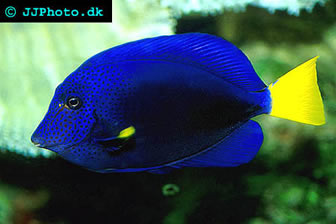Purple Tang
Zebrasoma xanthurum
The fish species Zebrasoma xanthurum is known under several different common names in English, such as Purple tang, Yellow tang, Yellowtail tang, Yellowtail sailfin tang, Dusky sailfin tang, Red Sea sailfin, Blue Surgeonfish, and Yellowtail surgeonfish.
Zebrasoma xanthurum has not been evaluated for the IUCN Red List of Threatened Species.
Geographical range, habitat and habits
The Purple tang lives in the Western Indian Ocean. Its range includes the Red Sea, the Persian Gulf, the Arabian Sea, the Gulf of Aden, and the waters of India, Sri Lanka and the Maldives. Earlier, it was believed to be endemic to the Red Sea. It has now been recorded off the coasts of the following countries: Bahrain, Djibouti, Egypt, Eritrea, India, Israel, Jordan, the Maldives, Oman, Saudi Arabia, Somalia, Sudan, Vietnam, and Yemen.
This is a reef-associated species that appreciate coral rich environments and rocky bottoms. Some individuals live alone while others form groups. Its depth range is 0-20 meters / 0-66 feet.
Size and appearance
The largest scientifically meausred Purple tang was 22.0 cm / 8.7 in.
This fish is bluish to purple with a yellow tail. The pectoral fins have yellow markings. The numerous teeth are small and suitable for grazing filamentous algae.
Purple tang care
The Purple tang needs open water for swimming as well as suitable hiding spots in the aquarium. Acropolis coral skeletons are known to be appreciated. It is not advisable to house the larger and active species in an aquarium smaller than 100 gallons / 375 litres.
Juveniles are known to be peaceful and they will often stay peaceful as adults as well if they are allowed to grow up together with other fishes in a non-crowded aquarium. Ideally add the Purple tang as the last fish to the aquarium.
The Purple tang can use its “scalpel” (spine) to defend itself and to establish dominance, but it prefers to scare other fish and will seldom retort to real violence. You should however avoid keeping the Purple tang with members of its own species or genus, especially if the species look similar to the Purple tang, since there is a high risk of actually injury in such situations. Similarly looking fish from other genera in the family Acanthuridae can also be a problem, particularly if they occupy the same niche.
This fish is considered reef safe with caution. It may nibble on stony corals with large polyps, especially from the genera Trachyphyllia and Catalaphyllia. Keeping your fish well-fed and giving it access to food around the clock (e.g. a piece of nori secured by a clothes-pin) can reduce the risk of coral destruction.
The recommended water temperature is 72-78º F / 22-25.5º C, the pH-value should be 8.1-8.4 and the specific gravity 1.020-1.025. Powerful water movements are strongly recommended. The oxygen level must be high if you want your Purple tang to thrive.
Feeding Purple tang
In the wild, the Purple tang feeds chiefly on micro-algae, but it will also eat macro-algae, fish eggs and tiny invertebrates that live among the algae. It is equipped with small pharyngeal teeth suitable for grazing on filamentous algae.
It is important to provide your fish with various types of algae food in the aquarium. Natural algae growth should be encouraged, but it is rarely enough to keep a Purple tang well-fed and it is therefore imperative to add extra food, e.g. in the form of fresh and dried algae from oriental food shops. The algae can preferably be combined with boiled vegetables such as broccoli and carrots and a high-quality flake food or pellets rich in vitamin A and C. Every now and then the fish should be given a small portion of meaty food, e.g. brine shrimp or mysid shrimp.
The Purple tang can store fat in its body cavities and can therefore survive limited periods without food. Hunger strikes are not that uncommon. If it happens, check the water values and carry out a water change.
Breeding Purple tang
It is hard to sex Purple tangs based on outer appearance outside the breeding period, but males tend to grow bigger than females. During the breeding period, the male will change colour.
We have no information about breeding Purple tang in aquariums.
Surgeonfish - Tang Articles:
Achilles Surgeonfish – Acanthurus achilles
Atlantic Blue Tang – Acanthurus coeruleus
Blue Hippo Tang – Paracanthurus hepatus
Chevron Tang – Ctenochaetus hawaiiensis
Clown Surgeonfish – Acanthurus lineatus
Convict Surgeonfish – Acanthurus triostegus
Desjardinii Tang – Zebrasoma desjardinii
Kole Tang – Ctenochaetus strigosus
Mimic Surgeonfish – Acanthurus pyroferus
Naso Tang – Naso lituratus
Orangeshoulder Surgeonfish – Acanthurus olivaceus
Powder Blue Tang – Acanthurus leucosternon
Powder Brown Tang – Acanthurus japonica
Sailfin Tang – Zebrasoma veliferum
Scopas Tang – Zebrasoma scopas
Whitecheek Surgeonfish – Acanthurus nigricans
Yellow Tang – Zebrasoma flavescens

